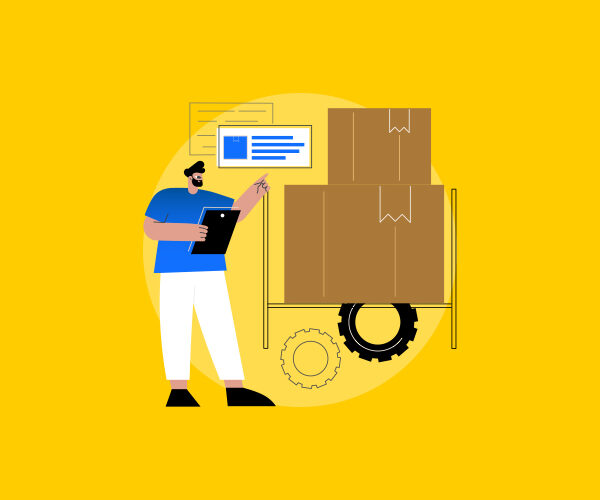Whether you are a wholesaler, distributor, or retailer, you must manage a large number of SKUs on a daily, weekly, or monthly basis.
You receive a product in your warehouse; you must keep a record.
If you sell a product, you need to keep that record as well.
Without a proper system to track products, a business might experience disruptions like stockouts and overstocking.
In the U.S. alone, stockouts cost retailers $82 billion in lost sales each year. Research shows that poor inventory tracking impacts business finances by up to 62%. That’s a significant amount of capital that could be used elsewhere, where it is more profitable. Therefore, keeping inventory tracking is not just an option; it’s a necessity.
Managing stockouts with a system that helps businesses keep track of their products and reduce stockouts can help reduce inventory costs by 10%. To ensure their business survives the challenges of stockouts, overstocking, long lead times, and manual errors, businesses use inventory scanning. They utilize technology that helps them scan, track, manage, control, and audit their inventory.
In this blog, we will break down what inventory scanning is, the tools involved, like inventory scan guns and barcode systems, and how to implement an inventory system that actually works. Lastly, we will discuss how Seebiz simplifies the entire process for wholesalers, distributors, and retailers.
What is an inventory scan?
Inventory scanning is a stock management system that integrates hardware tools like barcode scanners with software systems to manage stock levels, obtain product information, locate items, and manage orders.
It typically involves scanning barcodes, QR codes, or RFID tags linked to product information within your inventory database.
Without a proper scanning system and a database, it’s difficult for a business, large or small, to keep track of its inventory.

What makes a proper inventory scanning system?
Inventory scan comprises hardware and software tools to do a proper job.
Hardware:
Hardware used for the inventory scan includes;
- Scan guns
- Barcode scanners
- Mobile devices
- Label printers
Software:
Software used for the inventory scan includes;
- An inventory management system that has the functionality to integrate a scanning system.
Types of inventory scanning
Inventory scanning is of two types;
Manual tracking
There are different inventory scanning systems, such as periodic inventory scanning, in which businesses use ledgers or spreadsheets to manually count inventory regularly to keep track of their stock levels.
Automated tracking
Another inventory scanning system is perpetual inventory scanning, in which businesses use barcodes and RFID (radio-frequency identification) to track and manage their inventory and stock levels.
In this system, businesses typically use scan guns, mobile phones, or scanner apps available online and integrate them into their inventory database. By simply scanning the code on the product, all the data associated with the product (its origin, details, and current status such as in stock, sold out, or remaining) will be updated in real time.
The type of scanner you use determines how much information you can store in it.
Type of scanning solution used in US warehouses
1- Handheld Inventory Scan Guns
In US warehouses, handheld inventory scan guns are the most commonly used scanning solution. They use these guns to scan the codes attached to the products to record them in the database.
Rugged devices like the Datalogic QuickScan D2220 are highly used in US warehouses and retail backrooms.
Its popularity is due to its;
- 8-12 hour battery life for shift-long scanning
- MIL-STD-810G drop resistance (withstands 6-foot falls)
- 1D/2D scanning at 300-500 scans/second

2- Barcode scanning
Barcodes are unique codes made with a special combination of black-and-white lines or patterns that store information about a product. Barcode readers can read these codes.
Each barcode represents a product and links to a database with product details like SKU, description, and stock quantity.
Types of Barcodes:
- 1D Barcodes: Traditional barcodes used in retail and warehouses.
- 2D Barcodes (QR codes): Can store more information and are readable from any angle.
How to implement
- Design clear, scannable labels.
- Test if the scanner used is compatible with scanning it
- Make sure the software reads and processes the data correctly.
There are different types of barcode scanners available in the market, each with different functions. You should pick one that aligns with your business needs.

3- Mobile App-Based Scanning
Some apps turn your mobile camera into a scanner or simply use their own scanner. Apps like Sortly turn iPhones into scanners used by most US small businesses.
These apps perform the same function as barcode scanners: they record, access information, and manage stock levels.
4- Automated Robotic Scanning
This scanning is free from human intervention. As its name suggests, robots equipped with scanning abilities scan the 3D data associated with the product and record it in the database.
Simple and sophisticated!
5- Inventory Scan with Endpoint Central
Endpoint Central by ManageEngine is a unified endpoint management platform that includes inventory scanning. It helps IT teams manage digital assets, but it also has features for physical inventory tracking, like,
- Automatic asset discovery
- Real-time tracking
- Integration with security and patch management tools
How it Helps:
- You have centralized inventory visibility
- Better compliance and security
What challenges do businesses face in scanning their inventory?
Problem # 01:
Bad devices with poor connectivity and scan failure
Solution:
Use rugged, reliable devices that don’t break down in the middle of scanning and have spares available in case of emergency.
Problem # 02:
Damaged or missing barcode labels.
Solution:
To prevent such common problems, try using high-quality labels made with material that is not easily tearable.
Problem # 03:
Failure to integrate with the inventory management system
Solution:
Another problem is how most scanning devices work with software. Use platforms or devices that are easily integrated.
How SeeBiz simplifies inventory scanning for wholesalers
SeeBiz Inventory is built specifically for wholesalers, distributors, and retailers.
Here’s how it makes inventory scanning hassle-free:
- All-in-one dashboard: Manage products, stock, and orders in one place.
- Barcode ready: Generate, print, and scan barcodes directly from the platform.
- Mobile app support: Use your phone as a scanner on the go.
- Real-time syncing: Every scan updates your inventory instantly across all locations.
- custom workflows: Tailor scanning processes to fit your business.
- User access controls: Keep track of who scanned what, and when.
Where is the future taking us?
The time is just around the corner when AI will jump into scanning – more deeply. Robots are already used for repetitive tasks in big corporations. And soon, we will see an advancement in inventory scanning. Businesses will do smart forecasting based on their scan data using AI and predictive analytics. And there will be more flexible and wearable scanners that will reduce the need for different scanners for different codes.
Conclusion
Just imagine losing a big chunk of your sales because your stock runs out before the season ends.
I know it’s frustrating.
No matter how fast you try, the lead times will still cause your customers to trust your competitors. Therefore, for accurate scanning of your products, you need a more reliable system than ledgers and spreadsheets.
If you still haven’t, start with a simple barcode scanner and software that does your work, giving you access to your data all in one place.
If you are looking for a system that does both for you, check out Seebiz.
FAQs
What is an inventory scan?
Inventory scanning is a stock management system that uses hardware tools like barcode scanners and software systems to manage stock levels, obtain product information, locate items, and manage orders.
It typically involves scanning barcodes, QR codes, or RFID tags linked to product information within your inventory database.
What do we call an inventory scanner?
An inventory scanner is typically called a scan gun or barcode scanner. It’s a device used to read the barcodes attached to products to obtain information related to those products.
What is an inventory scan system?
An inventory scanning system integrates hardware such as barcode scanners and mobile app scanners with software like inventory management systems to automate management of stock levels, reordering, and order fulfillment, etc.



